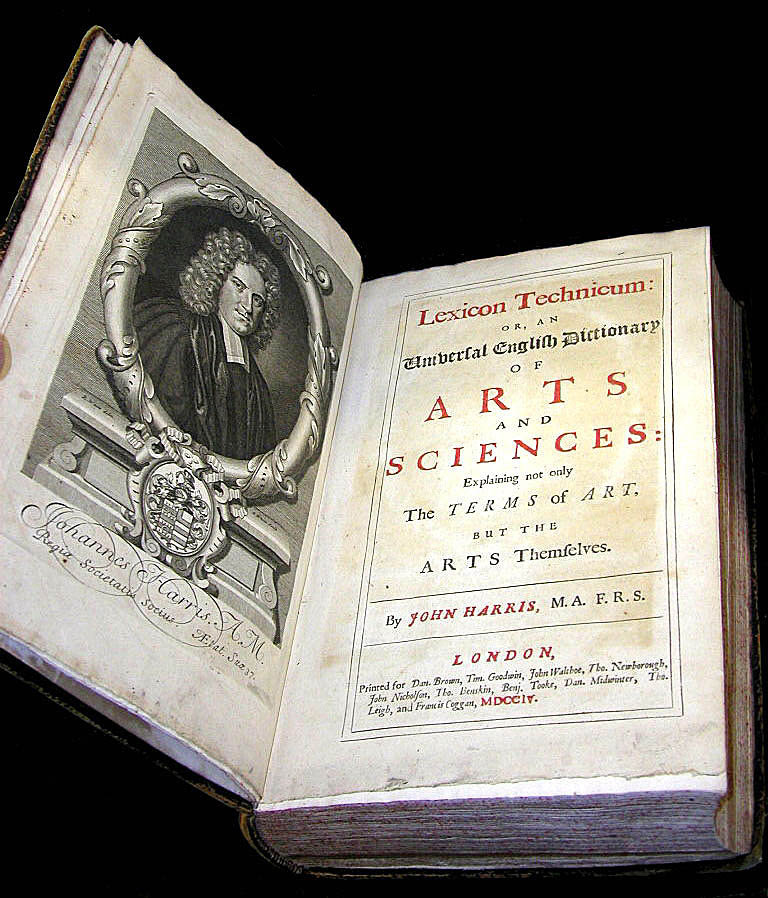

|
Lexicon Technicum: Or, An Universal English Dictionary of Arts and Sciences: Explaining not only the Terms of Art, but the Arts Themselves was in some respects the first alphabetical encyclopedia written in English, though it might rather be considered an encyclopedic dictionary. It was the work of a London clergyman, John Harris. The professed advance of the Lexicon Technicum is that it contains explanation not only of the terms used in the arts and sciences, but also of the arts and sciences themselves. Harris issued a three-page proposal for this work in 1702, and the first edition, in one volume, appeared in 1704. The second edition of volume I appeared 1708. Volume II was published in 1710. The emphasis of this work was on science -- and conformably to the broad 18th-century understanding of the term 'science', its content extends beyond what would be called science or technology today, and includes topics from the humanities and fine arts, e.g. a substantial number from law, commerce, music, and heraldry. Its scope can be considered as more that of an encyclopedic dictionary than a true encyclopedia. Harris himself considered it a dictionary; the work is one of the first technical dictionaries in any language. Isaac Newton contributed his only published work on chemistry to the second volume of 1710. The first volume was published in London, 1704, folio, 1220 pages, 4 plates, with many diagrams and figures printed in the text. Like many early English encyclopedias, the pages are not numbered -- numbering may have been thought unnecessary as readers could search by its alphabetical arrangement. Harris says that he found much less help from some previous dictionaries than one would expect from their titles. But he acknowledges the quality of Ozanam's Dictionnaire Mathematique (and implies that he would have taken from it if he had known less of mathematics himself); and he also expresses positive regard for the 'Chymical' and Physical Dictionaries of Johnson, Castellus, and Blanchard, and says of the latter that he has had transcribed many passages from it, crediting Blanchard by name at the end of each. But Harris adds that "much the greater part of what [the reader] will find here is collected from no Dictionaries, but from the best Original Authors I could procure". Harris omits theology, antiquity, biography and poetry; gives technical history, geography and chronology; and in logic, metaphysics, ethics, grammar and rhetoric, merely explains the terms used. In mathematics and anatomy he professes to be very full. The catalogue and places of the fixed stars are very imperfect, he says, as Flamsteed refused to assist him. Nevertheless in astronomy he gives, in full, Sir Isaac Newton's Theory of the Moon, "and a very large account of Comets from the same Author". In botany he gave from Dr John Ray, from 'Morison' ??Morrison, and Joseph Pitton de Tournefort, "a pretty exact botanick lexicon, which was what we really wanted before", with an account of all the "kinds and subalternate species of plants, and their specific differences" on Ray's method. He gave a table of fossils from Dr Woodward, professor of medicine in Gresham College, and took great pains to describe the parts of a ship accurately and particularly, going often on board himself for the purpose. In law, he abridged from the best writers what he thought necessary, and had the result "carefully examined and corrected by a Gentleman of known Ability in that Profession". The specified aims of the book did not prevent Harris from including some highly opinionated asides, such as a definition sharply conveying the poor view he clearly took of lawyers: "Sollicitor, is a Man imploy'd to take care of, and follow Suits depending in Courts of Law, or Equity, formerly allowed only to Nobility, whose Menial Servants they were; but now too frequently used by others, to the damage of the People, and the increase of Champerty and Maintenance". Harris wrote that he had wished to give at the end an alphabet for each art and science, and some more plates of anatomy and ships, but the undertakers could not afford it at the price, "the Book having swelled so very much beyond the Expectation". A review of his work, extending to the unusual length of four pages, appeared in the Philosophical Transactions, 1704, p. 1699. This volume also appeared in second and third editions in 1708 and 1715. A second volume of 1419 pages and 4 plates appeared in 1710, with a list of about 1300 subscribers. A great part of it consisted of mathematical and astronomical tables, as he intended his work to serve as a small mathematical library. He was allowed by Sir Isaac Newton to print his treatise on acids. He gives a table of logarithms to seven figures of decimals (44 pages), and one of sines, tangents and secants (120 pages), a list of books filling two pages, and an index of the articles in both volumes under 26 heads, filling 50 pages. The longest lists are law (1700 articles), chyrurgery, anatomy, geometry, fortification, botany and music. The mathematical and physical part is considered very able. He often mentions his authorities, and gives lists of books on particular subjects, as botany and chronology. His dictionary was long very popular. The fifth edition was published in 1736, fol. 2 vols. A supplement, including no new subjects, appeared in 1744, London, fol., 996 pages, 6 plates. It was intended to rival Ephraim Chambers's work, but, being considered a bookseller's speculation, was not well received. |